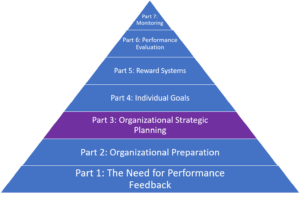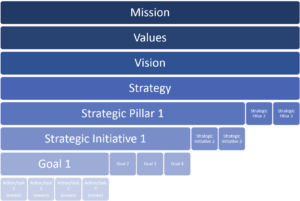Part 3:Performance Management Systems: Designing the Appropriate Organization Goals and Initiatives
By: KHA Consulting Team
The following is part four of a seven-part series on Performance Management Systems. This blog series includes identifying the need for performance feedback, designing organization and individual employee goals, establishing incentivization programs, and communicating and monitoring the system

Strategic Planning sounds ambiguous, so how do you Strategically Plan?
Fortunately for you interested readers, we wrote a nine-part series on the strategic planning process on our website that has been published under previous posts, Strategic Planning.
In our last installment we explored setting the table for the development of your organizational plan through a strategy primer, setting priority, and reviewing current policy. In this installment we will explore strategic planning for the organization through cohesion and macro and micro level strategy planning.
From a summary perspective to link to our current conversation on performance management, let’s briefly overview the strategic planning process and KHA’s approach. Organizational goals cannot be set without understanding the strategic plan of the organization.
The Need and the Gathering
First, we must identify the need for strategic planning and agree that it is critical for organizational success. Harvard Business Review highlights organizations that strategically plan have more success, https://hbr.org/2017/11/how-the-most-successful-teams-bridge-the-strategy-execution-gap. Second, we must get the right team to the strategic planning session to ensure fair representation, ownership, and ultimate alignment throughout the organization. As a note, it is critical to have an objective outsider facilitating this meeting at an offsite location (enter KHA Management Consultants at the KHA provided conference rooms). Much of the value in strategic planning is in the process rather than the end deliverable (i.e. new organizational rules). Keep this last thought in your mind as we continue.
Now that we understand why it is critical to strategically plan and have the right team at the meeting, we can get into the strategic planning process. In this blog, we will break the strategic planning process into three major parts, each of which will be reviewed below.
Part 1: Cohesion
Blog 2 of this series The Need for Cohesion reviewed setting the table and with the right audience, cohesion will be critical. Conflict is healthy, it really is critical for organizations to achieve balance. Organizations that are successful allow healthy disagreement and conflict of interests to be expressed and even encourage it to be brought up in the appropriate setting. However, when conflict turns to negatively targeting individuals, personnel in general, or departments, there is a major problem in the organization. Patrick Lencioni’s The Advantage is, by far, the best framework we have come across for cohesion development. In this book, the author provides an entire section dedicated to getting the leadership team on the same page for the organization’s mission and goals. There are four major components to establish management cohesion: establishing trust, gauging typical conflict, unified leadership, and accountability and conflict. This cohesion exercise is generally the first half-day of the two-day offsite strategic planning session that results in unbelievable transparency and communication.
Part 2: Macro-level Strategy

Ah, we had a good light lunch with your management team following our cohesion session; we now embark upon the organization specific strategy to define the mission of the organization clearly, succinctly, and fairly. This next exercise is about getting your management team on the same page, developing consistent messaging across all teams, and defining a mission that truly explains why the organization exists. KHA management consultants has activities we facilitate with your management team to ask prompting questions such as “What is your why?” and “What is your competitive advantage?”. These questions lead to robust and fruitful discussion in order to get the exercise off the ground and running.
The organization is then evaluated against the decided upon mission by looking to the values of the organization, including those core and unwanted values.
The mission, or the reason for existence, and values, components that make the organization unique, do not typically change; although, we certainly hope unwanted values do change and core values continue to be cultivated. All goals below the top mission and core values will and should change. Now, the next phase we get into is defining what your organization does and what it does well. Your organization must do this next phase better than most in the marketplace to be able to exploit a competitive advantage or realize profits. Those critical success factors for your organization must be brought to light, evaluated, and defined in this process of developing your organization’s strategic goals. If your organization cannot define how it will be successful both now and, in the future, it is time for us to have a different conversation. Ultimately, strategic planning is an organization’s plan for success. This concludes day one of our strategic planning consult.
Once the team knows how to be cohesive, and what the overarching mission, values, and competitive advantages are, we are ready to get more specific in designing the strategic plan. This next process can start a myriad of ways; we have had clients use an activity to define strategic pillars, we have also worked with other clients to cultivate and probe for those key anchors that will drive the strategy forward. These specific pillars will hold your organization up as it begins to establish itself on a new foundation.
Part 3: Micro-level Strategy
Good morning day two! Knowing the strategic and tactical gap is where most organizations falter; the meeting attendees must connect the specific goals with the overall strategy of your organization in a roadmap fashion. Your tactical goals, those goals that carry out achievement of the agreed-upon strategy, must be aligned with defined strategic initiatives if there is any hope of exploiting a competitive advantage over competitors. Strategic initiatives are those key overarching items that parse the strategy into specific action areas. Under each of your 3 strategic pillars, there should be 3 to 4 well thought out and vetted strategic initiatives, for a total of 9 to 12 strategic initiatives. For each initiative, there should be a testing process such as a modified strengths, weaknesses, opportunities, and threats matrix to identify if it really will bring the value it promises.
From here, goals and objectives need to be set for each strategic initiative and for each goal and objective, specific actions and tasks. The ultimate owners of each strategic initiative need to be identified, chartered, and monitored at each stage of each strategic anchor, strategic initiative, goal, and action. The organization owns the mission and values.
Communication

To have buy-in, there must be communication and action at each phase of the strategic planning process. Communication does not stop once the strategic plan is in place. Your management team must align before leaving the planning room and agree to communicate timelines for information to the rest of the organization. For commitment to be experienced at the organization, department, and individual employee levels (and any other key stakeholders that need to be included), is to allow for success.
In our next installment, we will discuss developing individual goals, including the identification of key performance indicators, targets, and the respective result implications.
At KHA Management Consultants, we work with organizations of all sizes and shapes to identify what makes the organization, its stakeholders, and its employees tick. We facilitate the performance management process with your organization’s key constituents to ensure buy-in, ownership, and a new way of thinking about the organization and its stakeholders among all levels of employment. From a resource perspective, we primarily use our unmatched experience but also tap into the top-level resources such as those provided by Harvard Business Review and MentorPlus. Some of those materials, frameworks, and lessons have been used in writing this blog.
KHA Management Consultants, the consulting department of KHA Accountants, PLLC, based in Flower Mound, Texas, is always looking for opportunities to work with key clients ready to take their business to the next level. If you have a desire to improve, take the first step toward success with the performance management experts, and contact us at 972-221-2500.

